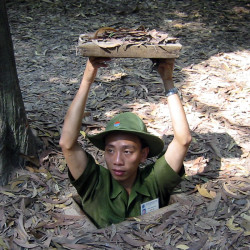Cu Chi is the name of a place where people used to live. Go there now and you’ll find a young jungle reclaiming its territory — trees and bushes almost thick enough to get lost in, but not quite yet. You’ll hear birds twittering, and you’ll see centipedes slinking, and you might glimpse a giant ant hill. You’ll feel like you’re on the fringes of a National Park. And then you’ll turn around a bend, and you’ll see a tank.
Cu Chi was the No Man’s Land of the Vietnamese-American war, now turned into a government-protected historical site. It’s 20km north of Saigon and surrounded by jungle — an ideal headquarters for the Viet Cong to launch attacks on American General Infantry then retreat. Until the Americans bombed it to hell. Over 50,000 tons of B-52 bombs fell on the area, creating a moon-like landscape, the craters still visible underneath the new jungle’s brush. The area was decimated — compact earth and almost no living creatures above ground — only dead leaves and dying trees. Nothing from then is still alive today.
Cu Chi is where the North persisted. The most (in)famous symbol of their determination are the Cu Chi Tunnels. A labyrinth of 200km, tendrils reaching below and beyond where any invading armies would think to look. Multiple layers of tunnels, with hidden doors and booby traps, meant that even if one entrance was found, the entire network was still protected. An engineering achievement. A brilliant war strategy. A perpetually hot, constricting home for the Viet Cong.
Cu Chi represents the horrors of war from the American side. Victor Charlie luring GIs deeper into the dead brush, only to be ambushed from behind; or to scream in agony while falling into hidden traps, their flesh ripped apart by bamboo spikes; or forced into claustrophobic underground tunnels, only to be bitten by venomous snakes let loose by trip wires. The idea of launching an offensive on Cu Chi must have terrified even the most determined GI. The physical realities of wounded and dying soldiers is obvious. The mental wounds would stay latent for years.
Cu Chi represents the horrors of war from the Vietnamese side. Hundreds of Viet Cong living in cramped underground tunnels. Only able to venture above ground at night. Only able to eat canned foods. Away from their husbands, wives, parents, and children. The earthquakes from American shells a constant during the day. Psychological warfare — children crying, asking where daddy has gone — played over loudspeakers by Americans at night. There were even some children born into those tunnels, who knew only that life. Malnourished and barely able to breath.
Cu Chi is the name of a place where people used to live. Where people used to fight. Go there now and you’ll find a jungle reclaiming its territory. You’ll feel the impacts of an ape-descended species, who graduated from sticks and stones to tools much more devastating. You’ll understand the physical and emotional scars. Almost fifty years after it ended, you’ll hear birds twittering, and you’ll see centipedes slinking, and you might glimpse a giant ant hill. You’ll feel like you’re on the fringes of a National Park. And you’ll see the how hopelessly futile our borders, our ideals, our wars are.
Background image by Thomas Schoch
